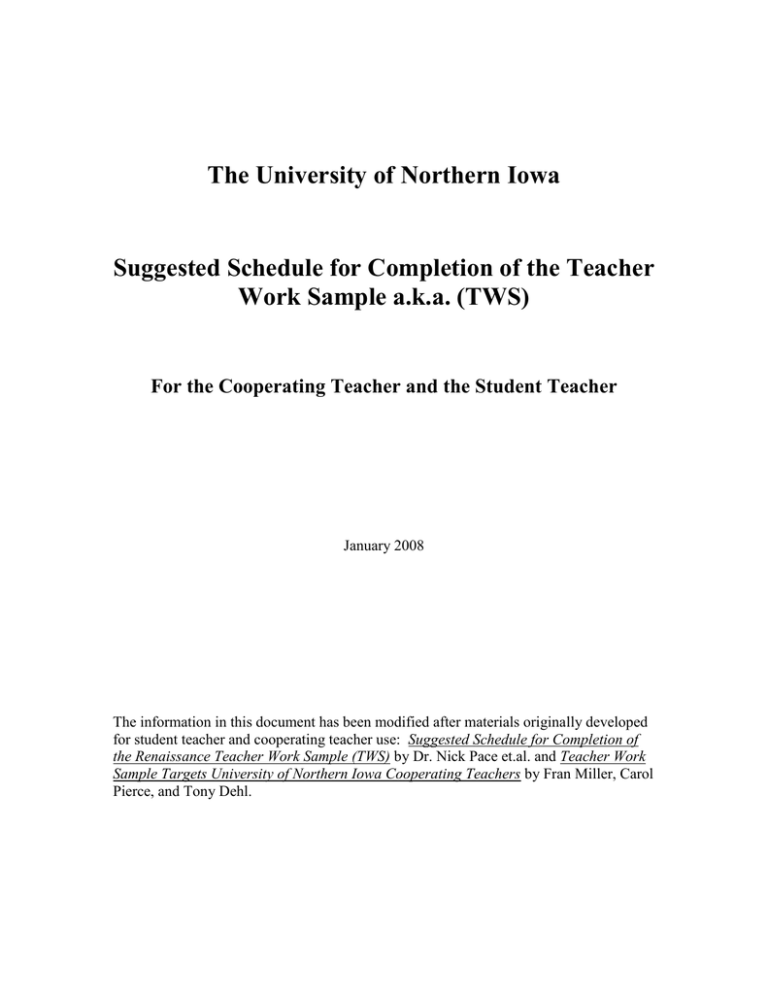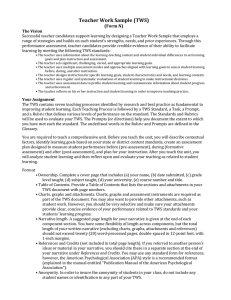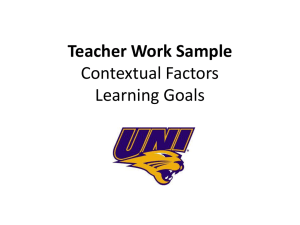The University of Northern Iowa Work Sample a.k.a. (TWS)
advertisement

The University of Northern Iowa Suggested Schedule for Completion of the Teacher Work Sample a.k.a. (TWS) For the Cooperating Teacher and the Student Teacher January 2008 The information in this document has been modified after materials originally developed for student teacher and cooperating teacher use: Suggested Schedule for Completion of the Renaissance Teacher Work Sample (TWS) by Dr. Nick Pace et.al. and Teacher Work Sample Targets University of Northern Iowa Cooperating Teachers by Fran Miller, Carol Pierce, and Tony Dehl. Instructor: Office: Phone #: email: Dr. Jim Kelly Professor of Teaching & Coordinator: Cedar Falls Student Teaching Center 541 Schindler Education Center 273-2808 james.kelly@uni.edu ________________________________________________________________________ From the College of Education Strategic Plan is offered the following selected and edited values that fit well with the human relations course. high expectations and excellence a futuristic orientation characterized by flexible, visionary thinking ethical practices the educator-scholar model the creation of vibrant learning opportunities, rich with choice educators who can affect change the holistic development of each person free exchange of ideas educators who demonstrate reflective thinking global citizenship and diversity democracy, social justice and environmental stewardship ______________________________________________________________________________ University Mission Statement The University of Northern Iowa is a comprehensive institution committed to providing a diverse, dynamic learning environment, founded on a strong liberal arts curriculum and characterized by excellence in teaching, research and service. ______________________________________________________________________________ College of Education Mission Statement The mission of the University of Northern Iowa, College of Education, is three-fold. First, the College exists to prepare educational and human service professionals for a variety of direct service and leadership roles in schools and non-school settings. Second, faculty members in the College conduct applied and basic research in the area of teaching and learning, human behavior, human growth and development, and educational policy. Third, the College of Education provides service on the local, state, regional, national, and international levels. By so doing, the College of Education effectively serves the profession by assuming a leadership role for the improvement of education and human services. ________________________________________________________________________ Qualifier: The University of Northern Iowa is an Affirmative Action Equal Opportunity Institution. The Americans with Disabilities Act of 1990 (ADA) provides protection from illegal discrimination for qualified individuals with disabilities. Students requesting instructional accommodations due to disabilities must arrange for such accommodation through the Office of Disability Services. The ODS is located at 213 Student Services Center and the phone number is 273-2676. 2 “Whether or not there is a better way than the ways we now use to organize and conduct schooling is beside the point. It might be the ‘best’ way, but that cannot be determined until we examine the assumptions upon which current practices rest and then consider the alternatives.” . . . Elliot Eisner. (1998) The Kind of Schools We Need. Portsmouth, NH: Heinemann, p. 3. ________________________________________________ Suggested Schedule for Completion of the Teacher Work Sample a.k.a. (TWS) Note to the CT and the ST: The cooperating teacher (CT) is a resource person for the student teacher (ST) and has no responsibility for the completion of the work sample. The CT is in a good position to help the ST in any number of ways, but the work sample is the responsibility of the student teacher. The CT is an excellent resource to: (1) help guide their student teacher toward appropriate contextual factors information or where resources exist so that such information can be attained; (2) share important information about the skills and characteristics of the students in their classrooms; (3) help their student teacher decide on the appropriate unit or curricular materials to be taught where the work sample will be the focus; (4) assist in planning the assessment component; and (5) review and make suggestions as the Design for Instruction is being considered. Simply know, the CT will work as collaboratively as they need to, but to reiterate, the work sample is the responsibility of the ST. Ongoing conferencing between the CT and ST is always helpful assuring the completion of the components, but also to assure that quality teaching is happening in the classroom with the students. Note to the ST: There is some flexibility built into producing your final product submission with the transition week scheduled to follow the first student teaching experience. This is a time when you can finalize your work sample and get it typed and ready for evaluation. As to using this document with all the other documents associated with the TWS, note, there is plenty of open space within this document where anecdotal notes can be written to help with organizational and ongoing planning. Week 1: To the CT: Please help your student teacher gather contextual factors and discuss with him or her how these influence your classroom, school, and community insofar as your instructional decision making is affected. Also, discuss what unit or curricula he or she may use for the development of the required Teacher Work Sample. 3 To the ST: Determine the topic or area of the curriculum that your work sample will cover. The area of study needs to be of sufficient length to span 2-3 weeks of instructional time, including the pre and post testing. Write the Contextual Factors section for your TWS (See the TWS Guide for prompts for writing contextual factors. Also note that there will be a seminar on this very topic.) Since the cooperating teacher will have greater knowledge of these factors or how to access them, the student teacher should confer with their CT and consult the district Annual Report. Begin writing the Learning Goals section (objectives) for the entire unit (See the TWS Guide for prompts for writing learning goals). Remember that the goals must include both knowledge goals and skill goals. The written goals must show the connections to the Program of Studies and/or the Core Content for Assessment. Begin to think about the Pre and Post Assessment instruments you want to use. Remember that the Pre and Post assessment instruments must be closely matched or even be the same. Also make sure that an adequate number of items exist for each of the goals. One or two items for each of the goals will normally not be enough to assure that the student has learned the information presented in the unit of study. You need to begin developing your assessment instruments prior to starting the unit. Determine the method of analysis you will use to know if the goals have been achieved. How will you know if the students have achieved the goals of the unit? Will you use raw scores? If so, how many must the children get correct for you to know they have achieved the goal? Will you use percent correct? If so, what percent is expected for each child and the class as a whole (mean score) for the goal(s) to be achieved? In the case of the pre-assessment, if any goal(s) has/have been achieved according to your method of analysis, i.e. the student already has learned what you want him/her to learn, you will need to consider how that goal will be treated in the instructional process. If, for example, a majority of the students indicate from the results of the pre-assessment that any goal has already been achieved, you would need to exclude that goal as part of the unit instruction or at the very most, do a quick review for that goal or re-design the goal. Notes: 4 Week 2: To the CT: Help your student teacher gather standards and benchmarks for the unit or curricula that he or she will be teaching for the work sample. If local standards are available, they can use them. If they don’t exist at this time, they can use national goals and/or subject specific standards that have been adopted by the respective professional organization. Visit with him or her regarding the development of the learning goals (objectives). To the ST: Administer the Pre-Assessment. While it is important to do this as early as possible, you may find you are unable to administer the exam at this time and it must be deferred to the third week. You need to follow what is available to you as decided between you and your classroom teacher. You do need sufficient time for making any changes in the goals, which may need to be made if the results indicate the goals have been learned already. Be certain to make note of changes in your original Design for Instruction as you do any of the instruction. You are free to make changes in the instructional process that you deem necessary to accomplish the goals of your work sample teaching. You should expect changes to be made because the formative assessments might suggest the need to make changes for those students who are not learning as you had expected when you wrote your original design for instruction. Set up the Assessment Plan Table of your TWS (See the Assessment Plan section of the TWS Guide for an example). It is not necessary for you to write the entire section of the Assessment Plan at this time. It is important, however, to know the formative assessments that you will be using during your instruction procedures. Since the Pre-assessment and Post-assessment instruments have already been determined by this time, you need only to add the formative assessments to your plan. If for some reason you don’t have the pre and post-assessment instruments decided, then now is the time to finalize the instruments you plan to use. Plan your day-by-day Design for Instruction (See Design for Instruction section of the TWS Guide for prompts to planning the work sample overview). Write your planned activities into the Instructional Block Plan for each day of the entire teaching unit/materials. Be sure to show when the formative assessments will be administered, as well as the learning activities planned for each of the goals. Remember to code each of the learning activities to show which goal(s) is/are connected to the activities. 5 Notes: Week 3 or 4 through Week 5 or 6: To the CT: Help validate the assessment tools that your student teacher will be using. Help them to align the objectives with the test items so that the data that they will be collecting will be realistic and useable. Your student teacher should be able to explain the lesson plan with respect to the learning goals, and you might visit with them about effective instructional methods, related activities and available resources including technology applications. If modifications are required, you might visit with them regarding the reasons for making the changes. To the ST: Begin your instruction. You may start any day of the week. It is not necessary to begin your teaching on a Monday. Your CT and the completion of previous curricula will probably determine the day you start teaching for your TWS. Be certain to make note of any changes in the original Design for Instruction as you begin teaching the curriculum for your work sample. The changes, along with all of your other acquired information will be used to write up the Instructional Decision-Making section of the TWS. Of course, you are free to make any changes in the instructional process that you deem necessary to accomplish your stated goals. In fact, changes are expected to be made because the formative assessments will prove the need to make those changes for your students who are not learning as you had expected from your original design for instruction. Collect samples of student work to include in your TWS Appendix. You may wish to focus on the three individual students that you identified in the Contextual Factors. Complete all instruction by the end of week 5 or 6. If the post-assessment indicates that further instruction may be needed for some of the students, time will be limited for you to do this as a follow-up if your instruction time goes beyond the 6th week. Simply be aware that if you do run past this end date, 6 you will need to be cognizant of the end of your student teaching, which will only be a short time away. Administer the post-assessment. Remember that the pre-assessment instrument and the post-assessment instrument must measure the same goals and the analysis for both must be identical. Analyze the post-assessment results. Develop a table and a graph for the data to depict the changes in the learning for each of the goals and for individual students. Remember, with all tables and graphs, you need to have titles and appropriate labels with indicative units in order for the reader to understand what these data pieces are representing. Also, if needed, provide appropriate keys. Determine the need for further instruction. If the results of the postassessment warrant further instruction, you may want to plan follow-up instruction or review before completing your teaching. Notes: After completing all instruction for the work sample: Week 7 or 8: To the CT: As your ST finishes with his or her work sample, you might visit with them regarding their data, the kinds of graphs and tables that they will use and reflect on the overall analysis. Depending on the amount of work sample that has been written, you can read and offer suggestions. We will ask that you verify by your signature that your student teacher’s work sample was completed during his or her student teaching tenure with you. The University of Northern Iowa student teaching coordinators thank you for being a cooperating teacher and allowing this process to happen during your mentorship. 7 To the ST: Compile all the data and begin writing the narrative for the Instructional Decision-Making section of the TWS (See the TWS Guide for the prompts for writing this section). Some of the coordinators have the transition week designed so as to allow you time to finalize your work sample. However, you may find it necessary to begin this process earlier in order to make certain that you have everything that you will need to write your final product. If you have kept detailed records of the changes in the original design for instruction, the writing of this section should be easy. Look at your notes on the changes and follow the prompts in the guide. Compile the information and begin writing the narrative for the Analysis of Learning Results section of the TWS (See the TWS Guide for the prompts for writing this section). The tables and graphs for the preassessment and the post-assessment for each learning goal and for each student must be included in this section. Utilize the data to focus a discussion about the two students selected in the contextual factors. Begin writing the narrative for the Reflection and Self-Evaluation section of the TWS (See the TWS Guide for the prompts for writing this section). Again, some of the coordinators have time built into the transition week for this writing. You be the judge as to how much time you have available to begin any writing. You need to wrap up your student teaching experience and if time is available to begin writing your narrative, so be it, but if you need time to finish up other requirements of your student teaching, do them first and do your writing during transition week. Create an Appendix for the TWS. Include the following in the appendix: A sample of the pre-assessment instrument, a sample of the post-assessment, a sample of each of the formative assessments, and samples of student work for some of the learning activities. Create a Table of Contents and a title page for the TWS. These should be informative and don’t require that they display an artistic flavor. Create a Works Cited page using the APA format (even if you embedded citations within your narration). Notes: 8 Go to www.uni.edu/stdteach/TWS/TWS%20Information.htm Click on these hot links for further Teacher Work Sample information. An Overview of the TWS General Advice Cover Page Contextual Factors Learning Goals Assessment Plan Design for Instruction Instructional Decision-Making Analysis of Student Learning Reflection and Self-Evaluation Teacher Work Sample Examples TWS Prompt and Rubric Instructional Adaptations Gifted Strategies/Websites Return to OSFE Main Page Additional Teacher Work Sample information provided by the Iowa Teacher Quality grant 9







